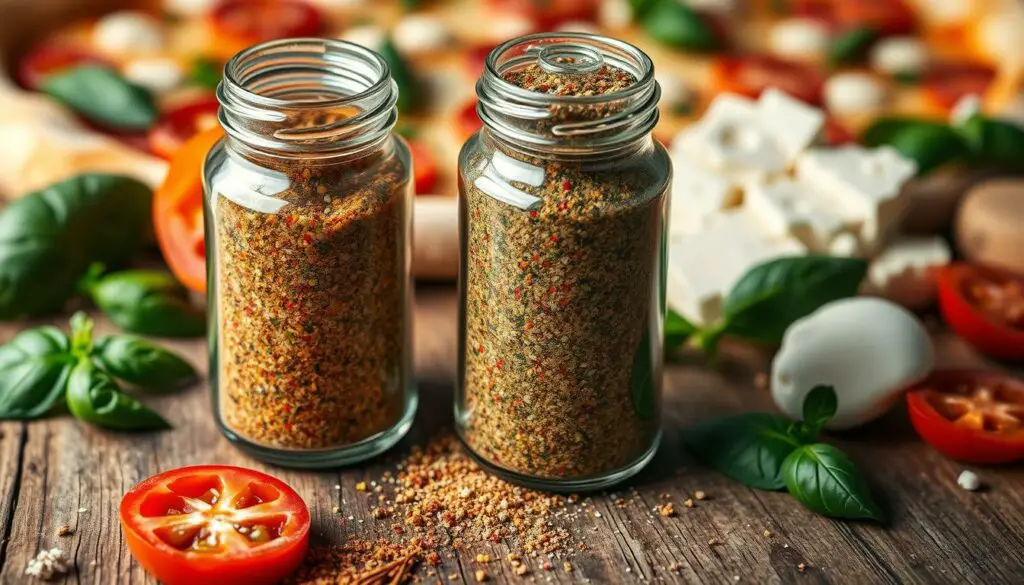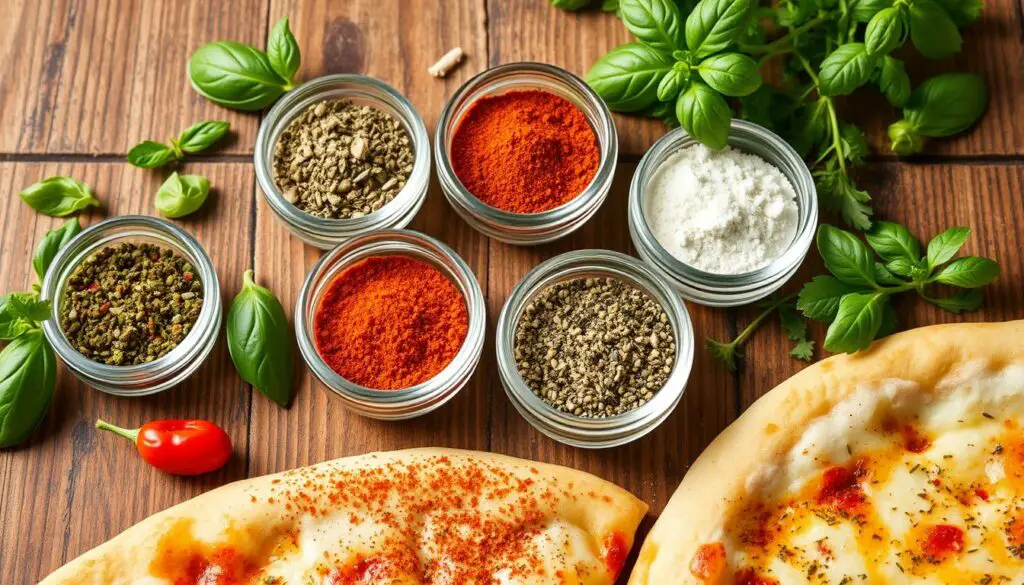
Ever wondered what makes Papa John’s pizza so delicious? What secret ingredient turns a regular pizza into a flavor explosion?
Papa John’s pizza seasoning is the secret to their amazing taste. This special mix of herbs and spices makes every slice special. It’s why Papa John’s is a favorite among pizza lovers.
Seasoning pizza is more than just salt and pepper. It’s about mixing flavors that make each bite unforgettable. It’s a culinary magic that turns a simple pizza into a memorable experience.
Key Takeaways
- Papa John’s seasoning is a unique blend of carefully selected herbs and spices
- The seasoning transforms an ordinary pizza into a gourmet experience
- Homemade pizza seasoning can be both cost-effective and delicious
- Freshly ground spices are crucial for maximum flavor impact
- The seasoning blend can be used beyond pizza for versatile cooking
Understanding Papa John’s Pizza Seasoning Magic
Papa John’s pizza seasoning is a special blend that makes their pizzas stand out. It’s made from a mix of ingredients that come together to give a unique taste. This blend turns a simple pizza into a memorable dish.

The Secret Behind the Iconic Flavor
The secret to Papa John’s seasoning is in its mix of ingredients. Key parts include:
- Garlic powder – provides a robust, aromatic base
- Black pepper – adds subtle heat and depth
- Salt – enhances overall flavor profile
- Paprika – contributes rich color and mild spiciness
- Oregano and thyme – introduce herbal notes
How This Seasoning Enhances Your Pizza
The seasoning boosts the flavor of Papa John’s pizza. Its dry mix ensures every bite tastes the same. This makes the pizza delicious from start to finish.
“Our seasoning is the silent hero that transforms a simple sauce and cheese combination into a culinary masterpiece.” – Papa John’s Chef
What Makes It Different from Regular Pizza Seasonings
Papa John’s seasoning is special because of its balanced taste. The right amounts of each ingredient make it unique. It’s different from other pizza seasonings on the market.
| Ingredient | Quantity | Purpose |
|---|---|---|
| Garlic Powder | 1 tbsp | Aromatic base |
| Black Pepper | 1 tbsp | Subtle heat |
| Paprika | 1 tbsp | Color and mild spice |
| Oregano | 4 tbsp | Herbal complexity |
Each ingredient is important for the unique Papa John’s flavor. It’s what makes their pizzas so loved by customers.
Essential Ingredients in Papa John’s Pizza Seasoning
Making the perfect pizza seasoning is all about mixing the right spices. Papa John’s seasoning is a special blend that makes any pasta or salad taste amazing.

- Paprika: Adds a vibrant red color and sweet pepper flavor
- Onion powder: Provides a rich, savory undertone
- Oregano: Brings an authentic Italian herb essence
- Thyme: Contributes an earthy, slightly minty note
- Black pepper: Delivers a subtle heat and depth
“The secret is in the balance of flavors, not just the individual spices.” – Pizza Seasoning Expert
Each spice is important for a seasoning blend that works wonders. It’s great on pizza but also on pasta, salads, and more.
| Ingredient | Quantity | Flavor Profile |
|---|---|---|
| Paprika | 2 1/2 tablespoons | Sweet, mild pepper flavor |
| Salt | 2 tablespoons | Enhances overall taste |
| Garlic Powder | 2 tablespoons | Robust, aromatic base |
| Black Pepper | 1 tablespoon | Adds subtle heat |
| Onion Powder | 1 tablespoon | Savory depth |
| Cayenne Pepper | 1 tablespoon | Spicy kick |
| Dried Oregano | 1 tablespoon | Herbal, Mediterranean touch |
| Dried Thyme | 1 tablespoon | Earthy, slightly minty |
Whether you’re making a homemade pizza or want to spice up a dish, this blend adds a pro touch. It makes your cooking taste like it’s from a restaurant.
The Perfect Blend: Mixing Your Own Seasoning
Creating your own pizza seasoning is a fun journey. It lets you add restaurant-quality flavor to your kitchen. Today, 75% of home cooks are making their own seasoning blends.
Making pizza seasoning at home is easy and saves money. You likely have most ingredients in your pantry. This makes it a budget-friendly recipe that lets you customize it.
Measuring and Combining Ingredients
When mixing your seasoning, being precise is key. Here’s a simple guide:
- Use a clean, dry tablespoon for accurate measurements
- Combine dried herbs evenly
- Stir ingredients thoroughly to distribute flavors
Storage Tips for Homemade Seasoning
Storing your seasoning right keeps its taste and strength. Follow these tips:
- Use an airtight glass container
- Store in a cool, dark place
- Keep away from direct sunlight and heat
Shelf Life and Freshness Guidelines
Your homemade pizza seasoning stays fresh for 3-6 months. Pro tip: Mark your container with the date you made it to keep track of freshness.
“The secret to great pizza is in the seasoning” – Pizza Enthusiasts
By making your own pizza seasoning, you’re part of a tasty trend. 90% of people use seasoning in their homemade pizzas. Have fun experimenting!
Spice Proportions and Measurements
Making the perfect pizza seasoning needs precision and careful measurement. The right mix of italian seasoning and herbs can turn a simple pizza into a masterpiece. Knowing the exact amounts is key to getting that special flavor.
When making your own pizza seasoning, keep these measurements in mind:
- 1 tablespoon dried basil
- 1 teaspoon dried oregano
- 1/2 teaspoon garlic powder
- 1/4 teaspoon cayenne for a subtle kick
- 1/8 teaspoon salt
The secret to seasoning is finding the right balance. A little cayenne can make your blend pop, while garlic powder adds a depth like garlic bread. Pizza pros know that small changes can make a big difference in taste.
| Ingredient | Quantity | Flavor Impact |
|---|---|---|
| Dried Basil | 1 tbsp | Primary herb base |
| Dried Oregano | 1 tsp | Authentic Italian touch |
| Garlic Powder | 1/2 tsp | Aromatic enhancement |
“Precision is the secret ingredient in creating restaurant-quality pizza seasoning.” – Pizza Seasoning Expert
Storing your seasoning blend is just as important. Keep it in an airtight container, away from sunlight and moisture. This way, your homemade italian seasoning will stay flavorful for up to three months.
Pro tip: Always measure ingredients carefully and adjust to your personal taste preferences!
How to Use Papa John’s Pizza Seasoning
Papa John’s pizza seasoning adds restaurant-quality flavor to your kitchen. It turns simple dishes into amazing meals with just a sprinkle.
Discover how to use papa john’s pizza seasoning to make your cooking better. There are many ways to enhance your dishes.
Before Baking Applications
Get the most flavor by using papa john’s pizza seasoning before baking:
- Dust pizza dough before stretching
- Mix into sauce for deeper taste
- Sprinkle directly onto pizza toppings
- Blend with olive oil for a quick marinade
After Baking Enhancement
Boost your dish’s flavor with seasoning after baking:
- Sprinkle generously over hot pizza
- Dust onto breadsticks and appetizers
- Create a finishing drizzle with seasoned olive oil
Beyond Pizza: Culinary Versatility
The flavor of papa john’s seasoning goes beyond pizza:
| Dish Category | Seasoning Suggestions |
|---|---|
| Pasta Dishes | Sprinkle on carbonara, alfredo, or marinara |
| Roasted Vegetables | Coat before baking for intense flavor |
| Salads | Use as a zesty dressing complement |
| Grilled Meats | Rub onto chicken, beef, or fish |
“A good seasoning can transform an ordinary meal into a memorable dining experience!” – Culinary Expert
Pro tip: Start with a light touch and adjust according to your taste preferences. The magic of papa john’s pizza seasoning lies in its balanced blend of herbs and spices.
Flavor Profile and Taste Analysis
Papa John’s pizza seasoning makes ordinary pizza into a masterpiece. It combines ground spices for a unique flavor with a spicy kick.
The seasoning has several key features:
- Cayenne pepper adds a subtle warmth
- Dried basil brings herbal aromas
- Ground spices add depth
- Roasted vegetables add earthy notes
When you sprinkle it on pizza sauce, it awakens your taste buds. It starts with a gentle spiciness that grows as you taste it.
“Great pizza seasoning transforms a simple meal into an extraordinary culinary journey” – Pizza Enthusiast Magazine
The seasoning’s mix works well with all pizza ingredients. It boosts roasted vegetables and matches traditional toppings. Each sprinkle brings a new flavor adventure to your pizza.
Creative Ways to Incorporate the Seasoning
Pizza seasoning is more than just for pizza. It can make many dishes taste amazing. Let’s dive into some fun ways to use it.
Exploring new ways to use your favorite seasoning can make meals special. Just a little sprinkle can change everything.
Pasta and Italian Dishes
Make your pasta salad even better with pizza seasoning. Here are some tasty ideas:
- Sprinkle over spaghetti carbonara
- Mix into pasta salad dressing
- Use as a finishing touch on lasagna
Bread and Appetizers
Make simple bread and appetizers taste amazing with this seasoning:
- Brush onto garlic bread before toasting
- Dust over focaccia
- Mix into olive oil for dipping
Vegetable Dishes and Salads
Pizza seasoning adds flavor to vegetables:
- Roast vegetables with a hot seasoning coating
- Sprinkle on green salads
- Mix into salad dressings
“Wir danken ihnen” for exploring new culinary horizons with pizza seasoning!
| Dish Category | Recommended Use | Flavor Impact |
|---|---|---|
| Pasta | Sprinkle after cooking | Medium-high |
| Bread | Brush before baking | High |
| Vegetables | Coat before roasting | Intense |
Pro tip: Start with a small amount and adjust to your taste preferences.
Health and Nutritional Information
Knowing the nutritional facts of pizza seasoning helps you choose better. A well-made blend can make your pizza taste great and might even be good for you.
The seasoning adds depth to your favorite tomato-based dishes, bringing more than just flavor to the table. Typical spice blends contain herbs and spices with remarkable nutritional properties:
- Antioxidant-rich herbs like oregano
- Metabolism-boosting spices such as black pepper
- Potential anti-inflammatory ingredients
Nutritional breakdown of typical pizza seasoning components:
| Ingredient | Calories | Key Nutrients |
|---|---|---|
| Dried Oregano | 3 per tsp | Vitamin K, Antioxidants |
| Garlic Powder | 10 per tsp | Vitamin B6, Manganese |
| Red Pepper Flakes | 6 per tsp | Capsaicin, Vitamin A |
When exploring something else in your spice pantry, consider hot spice combinations that complement your pizza. Moderation is key – while seasonings can enhance nutritional value, they should be used sparingly.
“Spices are nature’s flavor enhancers with hidden nutritional superpowers” – Culinary Nutrition Expert
Those monitoring sodium intake should be mindful of commercial seasoning blends. Homemade versions allow better control over salt content and ingredient quality.
Comparing Store-Bought vs Homemade Versions
Making the perfect pizza seasoning is all about finding the right mix of convenience and personal touch. Store-bought and homemade options each have their own special qualities to add to your cooking.
Homemade seasoning blends are a dream for those who love to cook at home. You can tweak the flavors by adding your favorite herbs like rosemary, olive, and garam masala. This lets you fine-tune your pizza’s taste just the way you like it.
- Store-bought seasonings offer a consistent taste
- Homemade blends let you play with ingredients
- Using pantry items can quickly upgrade your seasoning mix
“The secret to exceptional pizza seasoning lies in understanding your ingredients” – Pizza Culinary Expert
Getting the flavor right is key, whether you go for store-bought or homemade. Chefs say it’s smart to try out different mixes to find your favorite seasoning.
| Aspect | Store-Bought | Homemade |
|---|---|---|
| Convenience | High | Low |
| Customization | Limited | Extensive |
| Cost | Moderate | Low |
The article encourages trying both store-bought and homemade seasonings to find what works best for you. Each method has its own perks for making tasty, memorable meals.
Tips for Perfect Pizza Seasoning Application
Mastering pizza seasoning is an art that turns an ordinary pizza into a masterpiece. Both professional chefs and home cooks agree that the right approach makes a big difference. It can take your pizza from good to extraordinary.
Getting the flavors just right is all about careful thought and technique. Many pizza fans struggle with too much salt and hot seasonings. These can overpower the pizza’s delicate taste.
Common Mistakes to Avoid
- Don’t be too heavy-handed with parsley or other herbs
- Cut way back on salt to prevent making the pizza too salty
- Avoid uneven distribution of seasoning
- Be cautious with spicy seasonings
Professional Techniques for Seasoning
Professional chefs suggest a strategic seasoning approach. While some pizza orders come with free packets, making your own blend gives you more control. Here are some expert tips:
- Sprinkle seasonings lightly and evenly
- Taste as you go to avoid over-seasoning
- Adjust seasoning based on your personal preference
- Experiment with small amounts of new herbs
“The secret to perfect pizza seasoning is balance and restraint.” – Pizza Culinary Expert
Remember, seasoning is about enhancing, not hiding, the pizza’s natural flavors. A light touch can make a huge difference. It can turn a good pizza into an exceptional one.
Customizing Your Pizza Seasoning Blend
Making your own pizza seasoning blend lets you try new flavors and avoid too much salt. It’s all about finding the right mix of ingredients that you like.
Here are some tips for making your seasoning:
- Use herbs instead of salt to cut down on salt
- Change the heat with crushed red pepper flakes
- Try different herbs together
Begin with a basic mix of spices and add fresh herbs to make it better. Your goal is to create a seasoning that makes your pizza taste amazing.
“Seasoning is an art, not just a science – make it your own!” – Pizza Enthusiast
It’s important to not overdo it with salt and hot spices. Here’s a good starting point for your blend:
| Ingredient | Proportion | Notes |
|---|---|---|
| Dried Oregano | 2 tbsp | Base herb |
| Garlic Powder | 1 tbsp | Flavor enhancer |
| Crushed Red Pepper | 1 tsp | Adjust to taste |
Pro tip: Always taste and adjust your blend a little at a time to get the flavor just right!
Conclusion
The journey through Papa John’s pizza seasoning shows a special mix of spices. This mix, with olive oil and garlic salt, makes any meal special. It’s more than just for pizza.
This seasoning is very versatile. You can add heat to Indian dishes or sprinkle it on appetizers. It lets home chefs make dishes that taste like they’re from a restaurant.
Great seasoning is more than a flavor booster. It’s a way to be creative in the kitchen. Whether you’re cooking for a quick dinner or want to impress, Papa John’s seasoning is perfect. It’s a chance to make your cooking better and add a touch of professionalism.
FAQ
What exactly is Papa John’s Pizza Seasoning?
Papa John’s Pizza Seasoning is a special mix of herbs and spices. It’s made to make pizza taste better. It includes dried oregano, garlic powder, onion powder, salt, black pepper, and more.
Can I make Papa John’s Pizza Seasoning at home?
Yes, you can make it at home. Mix dried oregano, garlic powder, onion powder, salt, black pepper, and herbs like thyme or basil. The trick is to get the right mix of flavors.
How can I use Papa John’s Pizza Seasoning beyond pizza?
You can use it on roasted veggies, pasta, salads, garlic bread, and more. It’s great for adding flavor to Italian dishes.
Is Papa John’s Pizza Seasoning spicy?
The traditional mix isn’t very spicy. But, you can add cayenne pepper or crushed red pepper flakes to make it spicier.
How long can I store homemade pizza seasoning?
Homemade seasoning can last up to 6 months in an airtight container. Keep it in a cool, dry place away from sunlight and moisture.
Are there any low-sodium alternatives for the seasoning?
Yes, you can make a low-sodium version. Use less salt and add more herbs and spices. You can also use salt-free blends or garlic powder instead of salt.
Can I use Papa John’s Pizza Seasoning for dietary restrictions?
The seasoning is usually gluten-free. You can adjust it for other diets by checking ingredient labels and making changes.
What’s the best way to apply the seasoning to pizza?
Sprinkle it on the pizza sauce before adding toppings, or on the cheese before baking. You can also add a bit after baking for extra flavor.
